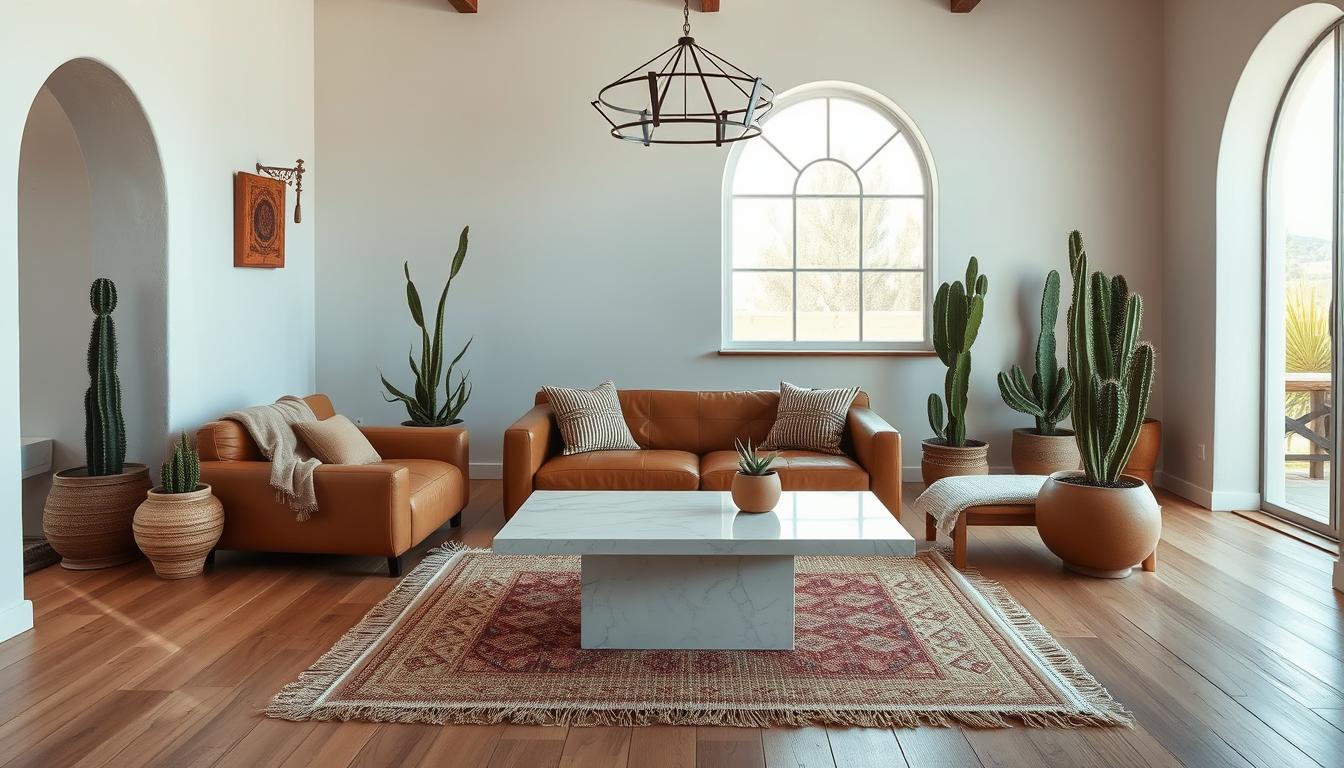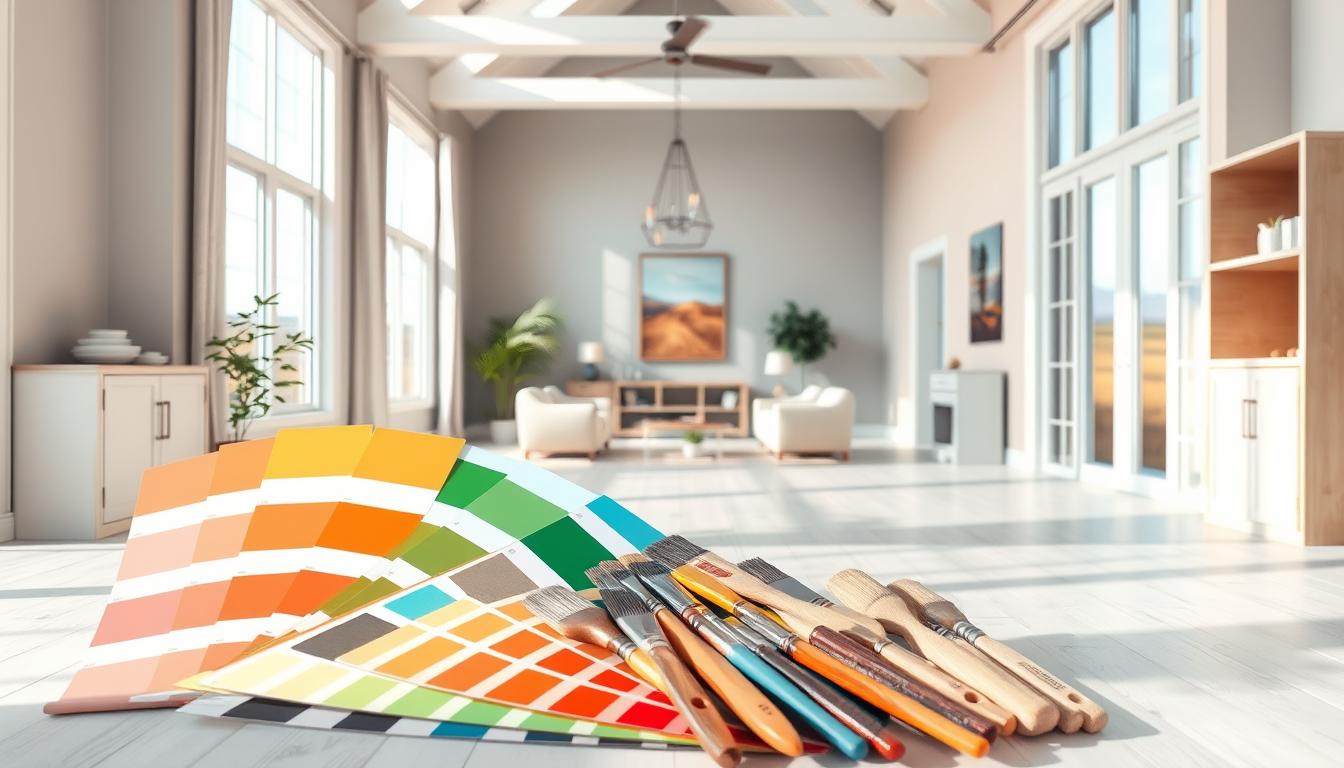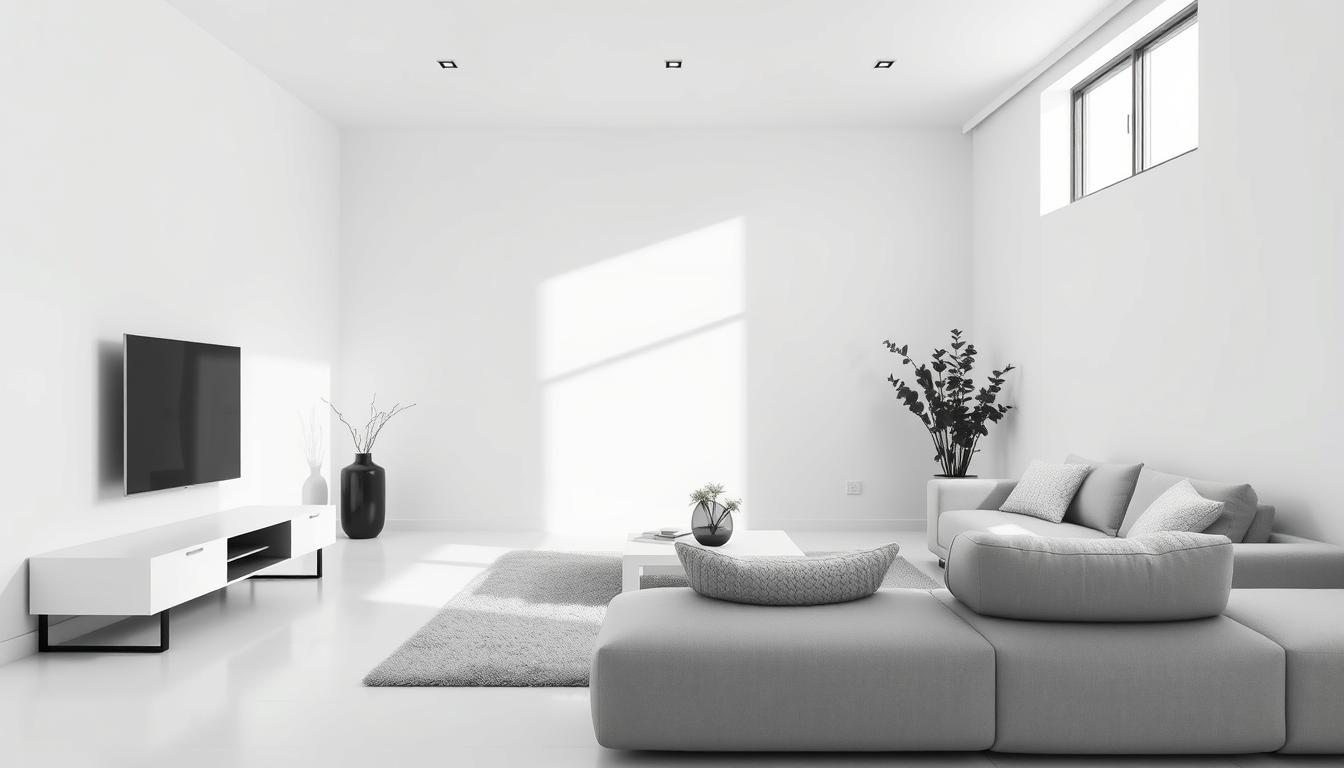Did you know Spanish-style homes are very popular in the U.S.? They are known for their warm feel. This comes from using earthy colors, rich textures, and fancy decorations.
Spanish home interior design is more than a style. It’s a way to add the lively colors and textures of Spain to your home.
We’ll dive into the history, key features, and new takes on this beautiful style. We’ll help you turn your home into a beautiful showcase of elegance.
Key Takeaways
- Discover the rich history behind Spanish-style homes
- Learn how to incorporate earthy tones and rich textures into your decor
- Explore modern interpretations of traditional Spanish design elements
- Transform your living space into a stunning reflection of Spanish elegance
- Understand the importance of ornate decorative elements in Spanish home interior design
What is Spanish Home Interior Design?
Spanish home interior design is known for its warm, earthy tones and detailed decorations. It brings a sense of warmth and welcome. This style is deeply connected to Spain’s rich history, influenced by Moorish, Gothic, and Renaissance architecture.
Overview of Spanish Style
Spanish home interior design focuses on creating cozy, welcoming spaces. It uses traditional Spanish architecture like terracotta tiles, wooden beams, and decorative tile work. These elements add warmth and history to a room.
The style also includes rustic Spanish interiors like vintage furniture and handmade textiles. This blend of old and new creates a unique, inviting space. It shows off the homeowner’s personal style.
Key Characteristics
Some key traits of Spanish home interior design are:
- Warm, earthy tones like terracotta reds and golden yellows for a cozy feel.
- Ornate decorations like intricate tile work and carved wooden pieces.
- A focus on cozy, intimate spaces for relaxing and socializing.
- The use of natural materials like wood and stone for texture and depth.
By using these elements, homeowners can make a Spanish-style home that’s both beautiful and practical. Whether you want a cozy retreat or a large, open space, Spanish design offers plenty of inspiration.
The History of Spanish Interior Design
The story of Spanish interior design is filled with cultural exchange and architectural innovation. It’s deeply connected to the country’s architecture and cultural influences.
Influence of Architecture
Spanish architecture has greatly shaped the country’s interior design. From the Moorish palaces in Granada to the Gothic cathedrals in Castile, different styles have influenced it. For example, Moorish architecture’s use of arches and intricate stone carvings has inspired similar elements in interior design.
Let’s look at the main architectural influences on Spanish interior design:
| Architectural Style | Influence on Interior Design | Characteristics |
|---|---|---|
| Moorish | Intricate patterns, arches | Use of geometric patterns, arabesques |
| Gothic | Ribbed vaults, ornate carvings | Pointed arches, ribbed ceilings |
| Spanish Colonial | Use of tiles, ornate furnishings | Bright colors, intricate woodwork |
Cultural Elements
Cultural elements have also shaped Spanish interior design. The use of vibrant colors, intricate patterns, and ornate textiles shows the country’s rich culture. For instance, the traditional Spanish art of azulejo tile-making has created stunning decorative pieces and functional items.
As we dive deeper into Spanish interior design, we’ll see how these cultural and architectural influences blend. They create a distinct and beautiful style that defines contemporary Spanish home design.
Key Elements of Spanish Home Design
Spanish home design is known for its warm, inviting look. It draws from the country’s rich culture. This style mixes traditional elements to make spaces cozy and welcoming.
Use of Color and Patterns
Color and patterns are key in Spanish home design. Warm earth tones like terracotta and sienna bring comfort. These colors are paired with detailed patterns in Spanish tiles and textiles.
Key patterns include:
- Geometric motifs inspired by Moorish architecture
- Floral patterns that reflect the country’s rich botanical heritage
- Intricate tile work that adds visual interest to walls and floors
Textures and Materials
Textures and materials are vital in Mediterranean home decor. Natural materials like wood, stone, and clay add depth. Wooden beams, for instance, bring rustic charm to homes.
Luxurious fabrics like velvet and linen add elegance. Mixing these textures and materials creates a rich atmosphere.
Popular materials include:
- Terracotta tiles for flooring and walls
- Wooden beams for ceilings and structural elements
- Decorative tile work for adding visual interest
Popular Color Palettes in Spanish Design
The color palette in Spanish interior design is key. It combines warm earth tones with bold accent colors. These colors show Spain’s rich culture and make homes feel welcoming.
Spanish design loves warm, earthy colors like terracotta, golden yellows, and deep blues. These are paired with bold colors like reds and oranges. This mix adds excitement to any room.
Warm Earth Tones
Warm earth tones are a big part of Spanish design. They’re inspired by Spain’s natural beauty. Colors like terracotta, sienna, and golden brown make spaces cozy and inviting.
Some top warm earth tones in Spanish design are:
- Terracotta: A warm, earthy red that makes rooms feel cozy.
- Sienna: A reddish-brown color that reminds us of Spain’s rich soil.
- Golden Brown: A warm, sunny color that brings comfort and relaxation.
Bold Accent Colors
Bold accent colors are also key in Spanish design. They add a splash of color and interest. Colors like vibrant reds, oranges, and yellows are popular.
Here’s a table showing a color palette inspired by modern Spanish decor:
| Color | Hex Code | Description |
|---|---|---|
| Terracotta | #E67E73 | A warm, earthy red color. |
| Golden Yellow | #F2C464 | A bright, sunny color that adds warmth. |
| Deep Blue | #3498DB | A rich, calming color that adds depth. |
| Vibrant Red | #E74C3C | A bold, energetic color that adds a pop of color. |
Using these colors in your design can make your space warm and inviting. It’s perfect for relaxing and entertaining, just like rustic Spanish interiors.
Furniture Styles in Spanish Interiors
Spanish home design is all about blending rustic charm with modern style. It combines traditional and modern elements to create a welcoming space.
Spanish furniture is known for its warm tones and detailed craftsmanship. It reflects the country’s rich culture. From wooden pieces to luxurious fabrics, each item adds to the home’s unique character.
Rustic and Traditional Pieces
Rustic and traditional furniture is key in Spanish homes. These pieces often have intricate carvings and are made from solid woods. A classic example is the traditional Spanish armchair, with detailed carvings and rich fabrics.
“The use of rustic furniture in Spanish homes not only adds warmth but also tells a story of tradition and heritage.” – Interior Design Expert
Common features of rustic and traditional Spanish furniture include:
- Use of natural materials like wood and stone
- Intricate carvings and ornate details
- Rich, warm color palettes
- Luxurious textiles and upholstery
| Furniture Piece | Characteristics | Materials |
|---|---|---|
| Traditional Armchair | Ornate carvings, luxurious upholstery | Wood, fabric |
| Rustic Wooden Table | Distressed finish, natural texture | Wood |
Modern Interpretations
Modern pieces also play a big role in Spanish interiors. They mix sleek lines with traditional materials. This creates a beautiful mix of old and new.
A modern Spanish living room might have a sleek sofa and a traditional wooden coffee table. This mix adds interest and makes the space unique.
Modern Spanish furniture often includes:
- Incorporation of modern materials like glass and steel
- Clean lines and minimalist designs
- Use of bold colors and patterns
- Mixing of traditional and contemporary pieces
By combining traditional and modern, Spanish interiors get a special look. They are both elegant and welcoming. Whether you want a cozy traditional feel or a modern look, Spanish furniture has lots to offer.
Incorporating Architectural Features
Architectural features are key in Spanish home design, giving a unique and timeless look. They add character and help make a Spanish-style home feel real and cohesive.
Arches and beams are standout features in Spanish design. They’re not just useful but also bring elegance and sophistication. Arches link rooms together, while beams, often made of wood or stone, add a rustic charm.
Arches and Beams
Arches and beams are crucial in Spanish colonial style, bringing history and grandeur to homes. They’re seen in doorways, windows, and ceilings. Adding them brings depth and interest to interiors.
Mediterranean home decor often uses arches and beams to blend indoor and outdoor spaces. This style focuses on natural materials, making homes warm and welcoming.
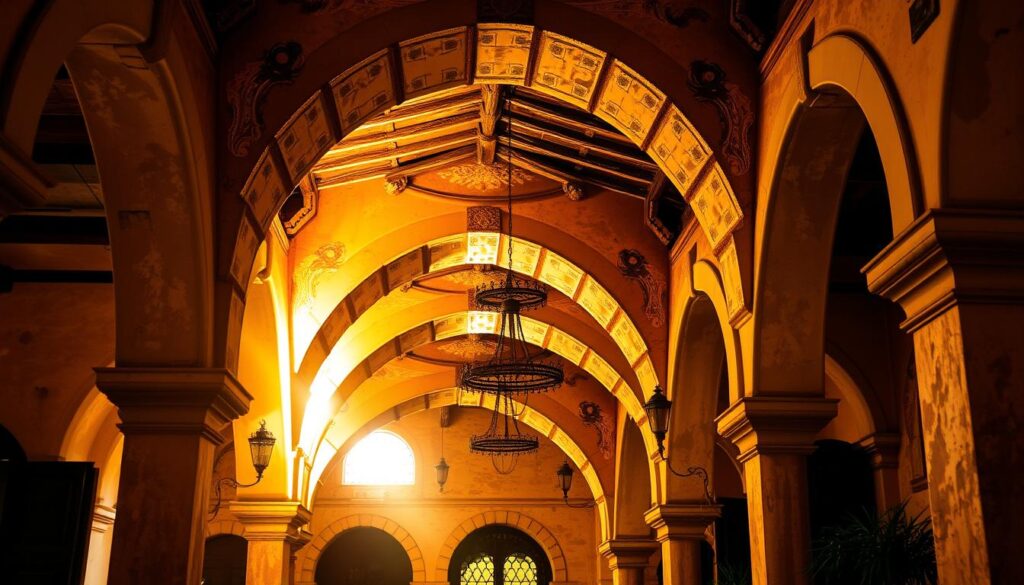
Tile Work
Tile work is vital in Spanish design. Azulejos, or decorative tiles, add color and pattern to walls, floors, and ceilings. They often have detailed designs and serve as room focal points.
Tile work in Spanish homes is not just beautiful but also keeps them cool in warm climates. By using tile work, you can create a stunning, authentic Spanish-style interior that’s both elegant and practical.
Spanish Textiles and Fabrics
Textiles in Spanish design are more than just practical items. They show off cultural heritage and personal style. Spain’s rich history and culture shine through in the wide variety of fabrics used in homes.
Spanish textiles and fabrics are known for their luxurious feel and detailed patterns. Velvet, linen, and other natural fibers bring elegance to a room. Patterned textiles, like embroidered fabrics and woven rugs, add depth and interest.
Types of Fabrics Used
In Spanish interiors, you’ll find many fabrics that make the space warm and inviting. Some common fabrics include:
- Linen: Its durability and natural texture make it great for upholstery and curtains.
- Velvet: It adds luxury to furniture and decor, common in traditional Spanish design.
- Cotton: Its versatility and comfort make it perfect for everyday use.
- Silk: Used in decorative accents and luxurious furnishings, silk adds sophistication.
Patterned Textiles
Patterned textiles are key in Spanish home decor, adding character and warmth. Embroidered fabrics and woven rugs are common examples. They often feature traditional Spanish motifs like floral patterns and geometric designs.
These textiles not only add visual interest but also help tie a room together. They’re used in upholstery, curtains, or as decorative accents. Patterned textiles are essential in modern Spanish decor.
By carefully choosing and using Spanish textiles and fabrics, homeowners can create a warm, inviting space. This space will reflect the beauty of Spanish home interior design.
Lighting in Spanish Home Design
Lighting is key in Spanish home design, blending looks and function. It changes a room’s feel, making it feel bigger, cozier, or more welcoming.
Maximizing Natural Light
Natural light is prized in Spanish homes, showing off traditional Spanish architecture. Big windows, often with detailed woodwork or iron, let sunlight in. This creates a warm light inside.
To get more natural light, try these tips:
- Use mirrors or shiny surfaces to spread light around.
- Choose light colors for walls and ceilings to reflect light.
- Keep windows clear of furniture or heavy curtains.
Decorative Lighting Fixtures
Rustic Spanish interiors also feature decorative lights that add elegance and warmth. You’ll find everything from wrought iron chandeliers to candle lanterns. Each piece helps create the cozy feel of Spanish homes.
Here are some decorative lighting ideas:
- Wrought iron or bronze lights that match Spanish design.
- Candle lanterns or pendant lights for a soft glow.
- Ornate chandeliers as room highlights.
By mixing natural light with decorative fixtures, homes become warm and inviting. This captures the essence of Spanish design.
Outdoor Spaces in Spanish Design
Spanish homes often have beautifully designed outdoor areas. These spaces reflect the country’s rich culture. They blend seamlessly with the indoor areas.
Traditional elements like terracotta tiles, ornate fountains, and lush greenery are key. These features add beauty and warmth to the outdoors. They make the space feel welcoming.
Patios and Terraces
Patios and terraces are vital in Spanish outdoor living. They’re decorated with Mediterranean home decor like detailed tiles, iron furniture, and colorful plants.
Terracotta tiles give the outdoor space a warm, earthy feel. Fountains and water features add a calming touch, perfect for unwinding.
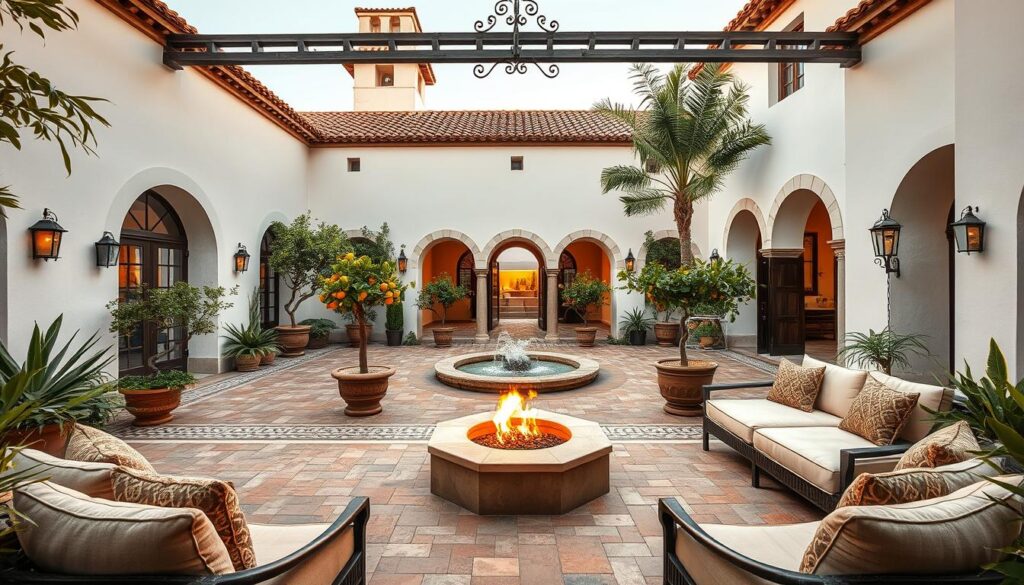
Gardens and Landscaping
Gardens and landscaping are essential in contemporary Spanish home design. The choice of plants is often based on local flora. Olive trees, lavender, and bougainvillea are favorites.
Lush landscaping boosts the beauty of the outdoor area. It also creates privacy and calm. Plants help define different spaces, like seating areas or paths.
By adding these elements, homeowners can make their outdoor spaces beautiful, functional, and inviting.
How to Achieve a Spanish Look
To bring warmth and elegance into your home, think about Spanish style. It’s rich in history and culture. We can mix traditional Spanish elements with modern decor to get this look.
Spanish home design focuses on warmth and coziness. Use rich colors, intricate patterns, and ornate details to create this feel. Here are some DIY tips to help you achieve this look.
DIY Tips and Tricks
To add a Spanish touch, start with simple DIY projects. Paint can add a pop of color to walls or furniture. Try earth tones like terracotta, sienna, or golden brown for warmth.
Decorative tile work is another way to bring Spanish style into your home. Create a stunning backsplash or add tiles to your staircase. Vintage tiles can give your decor an authentic feel.
Sourcing Authentic Materials
For an authentic Spanish-style home, finding the right materials is key. Look for vintage tiles, antique furniture, and traditional textiles. You can find these at local antique stores, flea markets, or online.
When searching for materials, think about their history and cultural significance. Traditional Spanish tiles are not just beautiful but also carry the country’s rich cultural heritage. Adding these elements brings depth and character to your home.
By using these DIY tips and authentic materials, we can create a unique Spanish-style home. It will reflect our personal taste and style.
Common Mistakes to Avoid
To make your Spanish-style home beautiful and functional, avoid some common design mistakes. When aiming for rustic Spanish interiors, it’s easy to get lost in rich colors and ornate details. But, some mistakes can ruin the look.
One big mistake is using too many colors. Traditional Spanish architecture loves bold and vibrant hues. But, too many colors can make a space feel too busy.
Overdoing Color Schemes
A Spanish-style home usually has a mix of warm earth tones and deep blues and greens. It’s key to balance these bold colors with neutral elements.
- Start with a neutral base: Use beige, cream, or soft gray as the primary color.
- Add bold accents: Incorporate traditional Spanish colors through furniture, textiles, or decorative pieces.
- Limit the number of bold colors: Stick to two or three main colors to maintain harmony.
For more DIY tips on achieving a balanced color scheme, visit our guide on DIY home interior design tips.
Neglecting Balance
Balance is key in any interior design, including Spanish-style homes. Without it, a space can feel too heavy or too empty.
| Element | Tips for Balance |
|---|---|
| Furniture | Mix large pieces with smaller ones to create visual interest. |
| Textiles | Combine patterned fabrics with solid colors to avoid overwhelming the space. |
| Decorative Items | Group items in odd numbers and vary their heights to create a balanced display. |
By avoiding these common mistakes, you can create a Spanish-style home that’s both authentic and welcoming. For more inspiration and guidance, check out our resources on traditional Spanish architecture and design principles.
Conclusion: Embracing Spanish Home Interior Design
Spanish home interior design is a mix of history, culture, and Mediterranean style. It uses warm colors, rustic furniture, and detailed textiles. These elements help create a cozy and elegant space that shows off Spanish beauty.
Bringing it all Together
To get a real Spanish vibe, balance bold colors and patterns with natural textures. Mix old and new pieces to make your space both classic and modern. Whether you love Mediterranean decor or Spanish style, aim for a welcoming and personal space.
Exploring Further
We suggest you keep exploring Spanish home interior design. It has a deep history, rich culture, and stunning looks. Spanish style is full of inspiration for making your home beautiful and meaningful.

